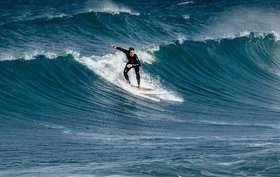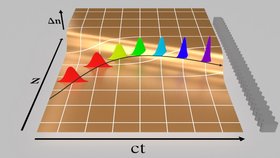Light surfing
17.09.2019

Most of us have been impressed by watching surfers, graciously sliding with an ocean wave. While we regular swimmers encounter a short and more or less shaking experience at the beach when a wave rolls over us, talented surfers have developed an ability to stay on a wave’s slope, maintaining their speed. A surfer on a slope of a water wave can continuously extract energy from the wave and use it for propulsion (Fig. 1a). The extracted energy is consumed by the work done against the water friction. For that, surfers need to precisely adjust the direction of their velocity.
A similar situation occurs when a light pulse interacts in a material with a moving front of refractive index as shown in Fig. 1b. In this case, no friction needs to be overcome and the extracted energy from the front is used instead to change the color (frequency) of the light.
Experienced surfers can balance their velocity direction such that they move laterally to the wave but do not leave the wave slope. The same effect can be achieved for light as well. In this case, the light pulse is trapped in the front and can continuously change its color (Fig. 1b) as long as the pulse stays on the front’s slope.
This effect can lead to further interesting consequences. If one considers a signal composed of several light pulses which start at different positions, these pulses will all be collected by the front leading to signal compression. Alternatively, a light pulse can also enter the front, surf on its slope, gaining a frequency shift and then accelerate and leave the front in the forward direction, just like a surfer would do in order to end the surfing motion. Also, transmission through the front can occur if the light pulse cannot accelerate enough and front takes it over, very much like the situation when the surfer finally finds himself behind the wave.

These and other novel effects are discussed in the recent invited review article for Nature Photonics journal written by scientists from Hamburg University of Technology (TUHH), Menoufia University, Yokohama University, Helmholtz-Zentrum Geesthacht and ITMO-University St. Petersburg. They present a unifying theory of the optical transitions induced by a moving front and discuss recent experimental results and possible applications.
The discussed effects go well beyond the fundamental physics of dynamic light interactions. The front induced frequency shift is relevant for frequency conversion in optical communications technology, where a packet of information can be switched from one frequency channel to another. Such a frequency shift can also be applied to single photons and used in quantum communication systems. The mechanism of light trapping in the front allows significant pulse compression and tunable delay.
The work was published on 16.09.2019 in Nature Photonics, one of the international scientific journals with the highest prestige.
Publication:
Online: https://www.nature.com/articles/s41566-019-0511-6
Front induced transitions, Mahmoud A. Gaafar, Toshihiko Baba, Manfred Eich and Alexander Yu. Petrov
Nature Photonics (2019), doi 10.1038/s41566-019-0511-6
Further information:
Prof. Dr. Manfred Eich
Hamburg University of Technology (TUHH)
Institute of Optical and Electronic Materials
Eißendorfer Straße 38, D-21073 Hamburg
and
The Institute of Materials Research
Helmholtz-Zentrum Geesthacht (HZG)
Max-Planck-Strasse 1, Geesthacht
D-21502, Germany,
Tel +49 40 42878 3147
E-Mail: m.eich@tuhh.de,
Dr. Alexander Petrov
Hamburg University of Technology (TUHH)
Institute of Optical and Electronic Materials
Eißendorfer Straße 38, D-21073 Hamburg
Tel +49 40 42878 3302
E-Mail: a.petrov@tuhh.de,
TUHH - Public Relations Office







